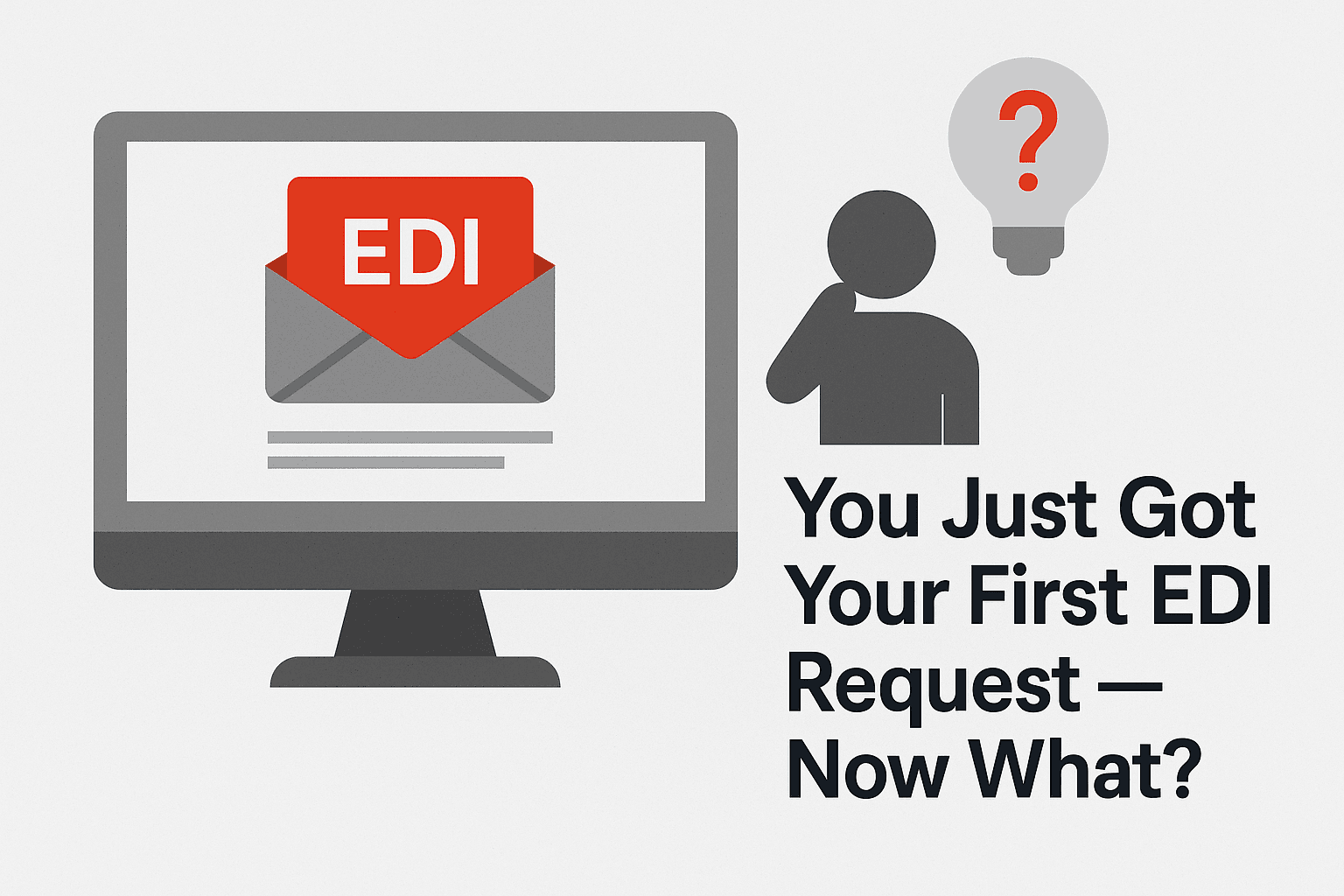Is a retailer asking for EDI? Get up to speed fast with this beginner’s guide to setup, trading partner expectations, and scalable web EDI solutions.
If you’re a small or midsize business, chances are your first exposure to electronic data interchange (EDI) didn't emerge as a result of your planning, but from a retailer or third-party logistics partner saying, “We need you to be EDI compliant.”
It’s a common scenario, and setting up your first EDI trading partner can feel a little overwhelming at first. But the good news is that implementing EDI doesn’t have to be complicated, expensive, or time-consuming. With the right steps and the right tools, you can easily add EDI to your existing systems to meet your trading partner’s requirements quickly and set yourself up for long-term efficiency.
This guide explains what trading partners expect and walks you through the EDI setup process so you can meet partner requirements and start leveraging EDI to drive business growth.
Why Partners Require EDI (And What Happens If You Don’t Act Fast)
Retailers and logistics providers rely on electronic data interchange (EDI) to streamline supply chains, improve order accuracy, and speed up fulfillment. By standardizing the exchange of electronic documents like purchase orders, invoices, and shipping notices, EDI eliminates manual processes that slow things down and introduce costly errors.
If you’re not set up for EDI, your onboarding can stall, and in some cases, your relationship with the partner may never get off the ground. Even if they allow temporary workarounds, delays in processing business documents or missing key transactions can hurt your performance metrics and affect future opportunities. That’s why many trading partners require it from day one.
Think of EDI not just as a compliance box to check but as a foundational tool for growing your business. The sooner you can send and receive documents electronically, the faster you can meet partner expectations and open the door to long-term supply chain partnerships.
Understanding EDI Requirements from Your First Trading Partner
Electronic data interchange (EDI) is a method for exchanging business documents in a standardized, electronic format. Instead of emailing PDFs or manually keying data into portals, EDI lets companies directly send and receive structured data, like purchase orders and invoices, between systems. This approach reduces manual processes, speeds up communication, and improves data accuracy across the supply chain.
Most trading partners will expect a few core EDI transactions. These usually include:
EDI 850 – Purchase Order: This document signals what the buyer wants to purchase and in what quantity
EDI 856 – Advance Ship Notice (ASN): This document details what's being shipped, when, and how
EDI 810 – Invoice: This document contains billing and payment information
Some partners may also require 997 Functional Acknowledgments, which confirm receipt of your EDI documents and help avoid missed or duplicate transmissions.
Each trading partner typically provides its own onboarding materials, including documentation outlining accepted EDI standards, required document types, and any unique data elements or communication protocols. You may be asked to use a specific portal, follow a set communication method like AS2 or FTP, or apply formatting rules that vary slightly from other partners.
It's critical that you read their documentation carefully, paying close attention to the fields they flag as required and what counts as timely delivery for each transaction. This upfront understanding helps prevent delays, rejections, or errors during setup and ensures smoother data exchange from the start.
EDI Code | Document Name | Purpose |
|---|---|---|
850 | Purchase Order | Tells supplier what buyer wants to purchase |
856 | Advance Ship Notice | Provides shipment details and timing |
810 | Invoice | Billing and payment information |
997 | Functional Acknowledgment | Confirms receipt of documents |
How to Set Up EDI for the First Time: A Practical Checklist
Setting up EDI for the first time is an easily manageable process when you break it into clear steps. Whether you're handling it in-house or partnering with a provider, the same basic EDI process applies. This simple EDI checklist will help you move from request to implementation with confidence.
Step 1: Review Your Partner’s EDI Requirements
Before you dive into setup, revisit your partner’s onboarding materials with a clear eye on what needs to be delivered, when, and how. Look for document types, accepted EDI standards, supported communication methods, and any formatting quirks unique to their portal. Clarifying these early ensures your solution aligns with their expectations and prevents rework later in the process.
Step 2: Choose the Right EDI Solution
You have a few options depending on your internal resources and technical needs.
Traditional EDI VANs or managed services can handle most of the complexity for you, but they can be costly and slower to set up.
In-house solutions give you full control, but they require experienced developers and more time to build.
Web EDI platforms offer the fastest route for most first-time users. These solutions integrate with existing systems, support standard data mapping, and simplify the overall EDI implementation process.
No matter which path you choose, make sure the solution supports the data exchange formats your partner requires and can scale as your business grows.
Step 3: Set Up and Validate Test Transactions
Before going live, you’ll run test transactions with your trading partner to confirm that your documents are correctly formatted and that they transmit properly. This step plays a crucial role in identifying data-element errors, missing fields, or mismatched communication protocols. Testing ensures your system will work well with theirs and can handle the flow of EDI data without introducing human errors.
Step 4: Go Live and Monitor Performance
Once testing is complete, you’ll transition into production, often called the "go-live." But EDI success doesn’t stop there. It’s important to monitor your transactions early to catch any issues, such as failed transmissions, delayed acknowledgments, or mismatched order data.
Many EDI providers offer built-in error handling, alerting, and reporting tools to support continuous improvement and reduce the burden of manual processes. Periodic audits of your transaction history and processing times can also help you identify bottlenecks, track partner satisfaction, and improve the overall efficiency of your EDI processes over time.
Why Web EDI Is Ideal for First-Time Trading Partners
For first-time suppliers, an EDI web fulfillment solution offers the fastest and simplest way to meet a trading partner’s EDI requirements. You can easily operate these platforms from a browser, allowing you to start exchanging information without investing in costly infrastructure or building custom integrations.
Because web EDI solutions are hosted and maintained by the provider, there’s no need to involve a technical team or modify your current system. You simply log in, fill out standardized forms, and send or receive transactions in the format your partner expects. This streamlined onboarding process makes web EDI especially appealing for companies with limited IT resources or tight go-live deadlines.
Web EDI platforms typically have the flexibility to support a wide range of document types, communication protocols, and EDI standards, enabling you to connect with multiple trading partners through a single, centralized interface. This reduces the risk of manual tasks, speeds up the onboarding process, and lays the foundation for long-term growth.
Why Orderful’s Web EDI Is Built for New EDI Users
If you’re just starting your EDI journey, Orderful’s web EDI platform is a flexible solution designed to help you launch quickly and scale confidently. Our platform includes pre-built forms for common EDI transactions, built-in error handling, and seamless connections to major retailers and third-party logistics (3PL) services, pre-loaded with all the key elements necessary to get you going.
Unlike traditional EDI software, Orderful is self-serve and doesn’t require a dedicated IT team to set up. You can start exchanging electronic documents with your first partner in a matter of days and monitor everything from a single, easy-to-use dashboard.
Orderful also offers robust support for first-time users, including documentation, validation tools, and access to EDI experts when you need them. Whether you’re integrating EDI systems for the first time or looking for a more scalable solution, Orderful helps eliminate human errors, improve data accuracy, and position your business for long-term success.
FAQs on The First EDI Request
What is an EDI request in business?
An EDI request means a retailer or partner requires you to exchange business documents in a standard electronic format and become EDI compliant to work with them.
What EDI documents do partners request first?
The first set usually includes EDI 850 purchase orders, EDI 856 advance ship notices, EDI 810 invoices, and 997 functional acknowledgments to confirm receipt.
How quickly can I become EDI compliant?
Most first-time suppliers can go live in days with a web EDI platform. Timelines depend on your partner’s testing schedule and how fast you provide item and shipping data.
Do I need a VAN or can I use web EDI?
You can use either. A VAN or managed service handles more for you. Web EDI is faster to start, lower cost, and ideal for a first trading partner.
What is a 997 functional acknowledgment?
A 997 is a confirmation that your EDI file was received and syntactically valid. It helps prevent missed or duplicate transactions.
What does testing before go live include?
Testing covers mapping validation, required fields, sample 850 to 856 to 810 flows, and verifying transport like AS2 or SFTP. Your partner will confirm each document passes.
What if my partner requires AS2 and I do not have it?
Use a provider that offers hosted AS2. They supply the certificate exchange, encryption, and receipts so you do not need to run AS2 in house.
How much does first-time EDI setup cost?
Costs vary by provider and volume. Many web EDI plans start with low monthly fees and per-document pricing that scales as you add partners.
How do I avoid chargebacks related to EDI errors?
Follow your partner’s implementation guide, send 997s, validate required fields, and monitor alerts after go live. Automate ASNs and invoices to cut manual errors.
Your First Partner Is Just the Start
Onboarding with your first EDI trading partner is a major milestone, but it’s just the beginning. As your business grows, more of your customers and logistics providers will expect EDI capabilities from the start. By building a strong foundation now, you’ll be better prepared to meet future requirements, expand your network, and keep your operations running at scale.
Whether you’re working with a single retailer or preparing to connect with dozens of new trading partners, having the right tools in place makes all the difference. A flexible, easy-to-use web EDI solution can help you avoid delays, improve accuracy, and drive efficiency across your entire supply chain.
If you're ready to get started, reach out and connect with an EDI expert today. See how Orderful can help you make your first EDI connection a success.

